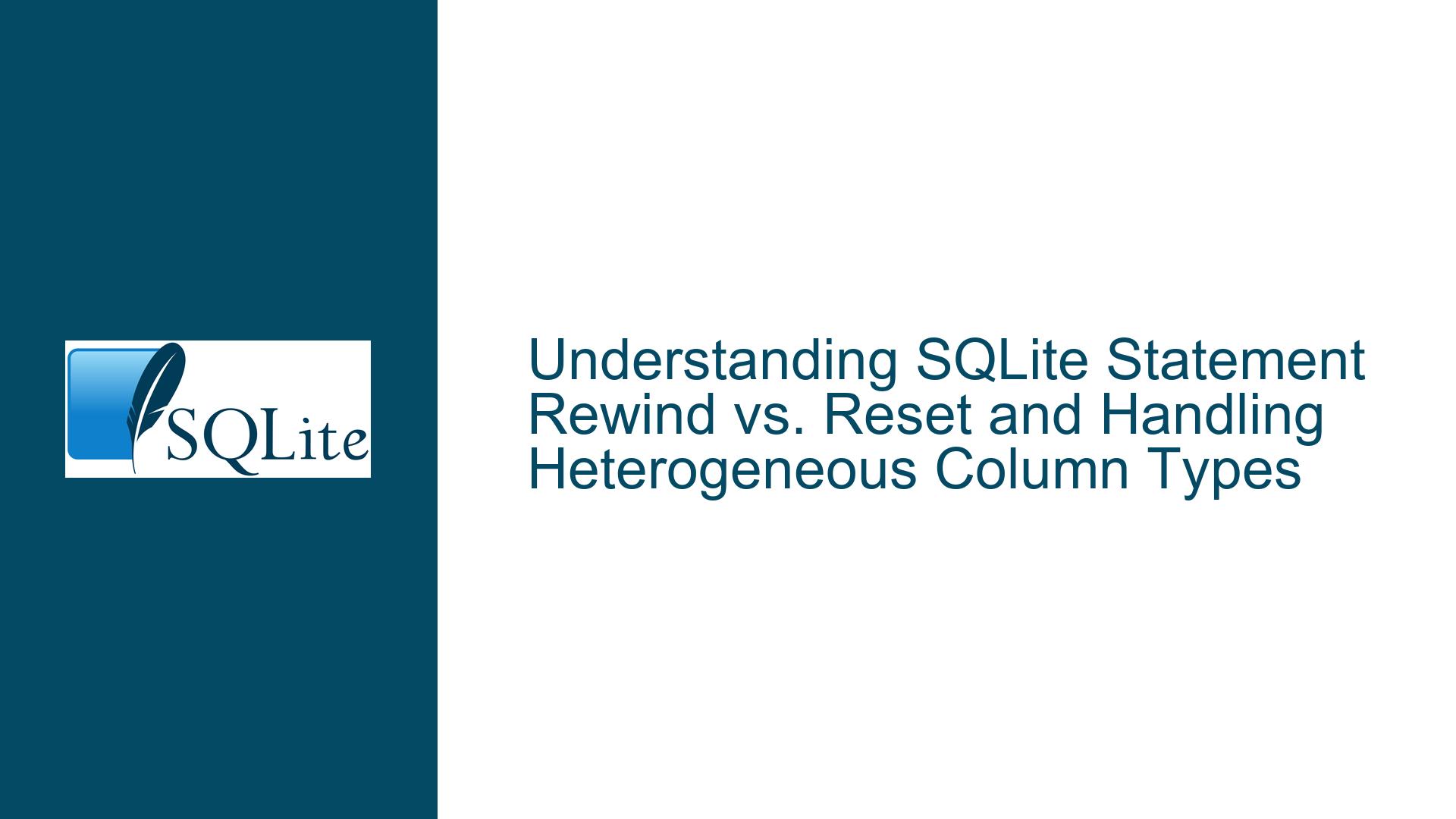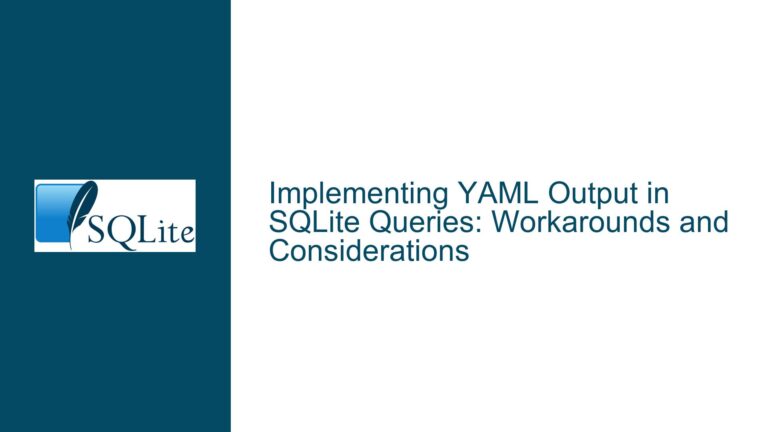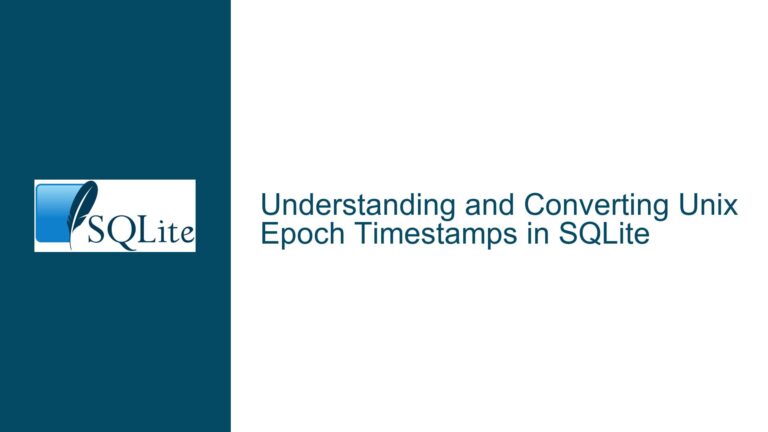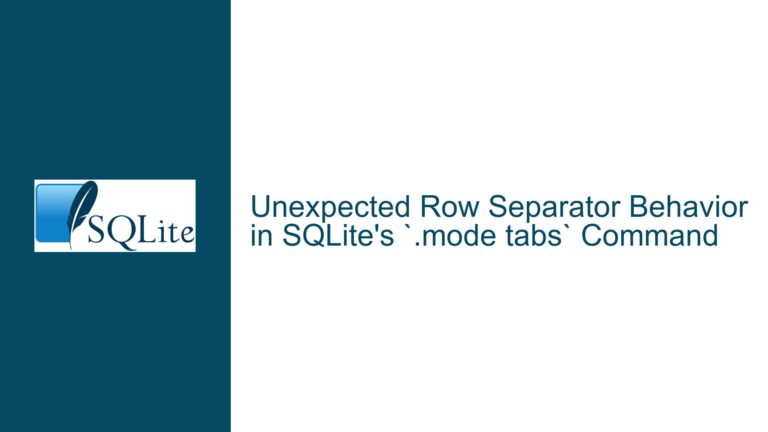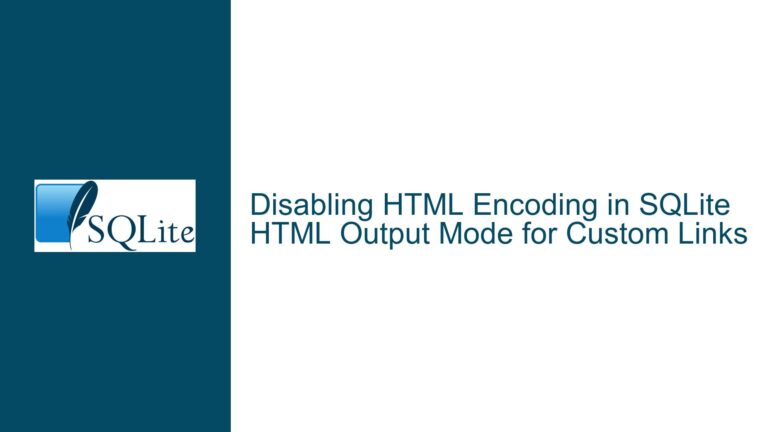SQLite Statement Rewind vs. Reset and Handling Heterogeneous Column Types
Issue Overview: SQLite Statement Rewind vs. Reset and Dynamic Typing Challenges
SQLite’s dynamic typing system allows columns to store values of different data types, which can pose challenges when working with tools or applications that expect homogeneous column data types. This issue becomes particularly pronounced when dealing with arbitrary queries, where the data types of columns are not known in advance. The core problem revolves around determining the data type of a column when the first row contains a NULL value, as NULL does not provide any information about the underlying data type (e.g., text, blob, numeric, etc.).
The discussion centers around a proposed solution involving the use of sqlite3VdbeRewind() to avoid re-executing a query while still being able to traverse the result set multiple times. The goal is to determine the data types of columns by examining non-NULL values in subsequent rows without incurring the overhead of re-executing the query. However, this approach raises questions about whether sqlite3VdbeRewind() effectively re-executes the query or simply allows re-traversal of the existing result set.
Additionally, the discussion touches on the limitations of SQLite’s dynamic typing system, particularly when dealing with expression columns or columns that may contain NULL values. The challenge is to reliably determine the data type of a column without manipulating the query or making assumptions about the data.
Possible Causes: Why SQLite’s Dynamic Typing and Rewind Behavior Complicate Data Type Determination
The root cause of the issue lies in SQLite’s dynamic typing system, which allows columns to store values of different data types. Unlike traditional databases like MySQL or PostgreSQL, where columns have a fixed data type, SQLite’s flexibility can lead to situations where the data type of a column is not immediately apparent, especially when the first row contains a NULL value. This flexibility is a double-edged sword: while it allows for greater versatility in data storage, it complicates scenarios where tools or applications require homogeneous column data types.
The proposed solution of using sqlite3VdbeRewind() to avoid re-executing the query introduces another layer of complexity. The behavior of sqlite3VdbeRewind() is not well-documented in the public API, and its interaction with sqlite3_step() and sqlite3_reset() is not immediately clear. The key question is whether sqlite3VdbeRewind() re-executes the query or simply resets the internal state of the virtual machine to allow re-traversal of the existing result set. If it re-executes the query, then the proposed solution may not provide the desired performance benefits. If it does not re-execute the query, then it may be a viable approach for determining column data types without incurring additional overhead.
Another contributing factor is the lack of a built-in mechanism in SQLite to determine the data type of a column without examining the actual data. While sqlite3_column_decltype() can be used to retrieve the declared type of a column, this function is only useful for columns that originate directly from a table. For expression columns or columns with NULL values, there is no way to determine the data type without examining the data itself. This limitation forces developers to implement workarounds, such as buffering the entire result set or using temporary tables, which can have significant performance implications.
Troubleshooting Steps, Solutions & Fixes: Strategies for Handling Heterogeneous Column Types and Rewind Behavior
To address the challenges posed by SQLite’s dynamic typing system and the behavior of sqlite3VdbeRewind(), several strategies can be employed. Each approach has its own trade-offs, and the best solution will depend on the specific requirements of the application.
1. Buffering the Entire Result Set
One straightforward approach is to buffer the entire result set in memory or on disk. This allows the application to examine all rows and determine the data types of columns before processing the data. While this approach ensures that the data types are accurately determined, it can have significant memory or disk space requirements, especially for large result sets.
To implement this approach, the application would first execute the query and store all rows in a temporary data structure, such as an array or a temporary table. Once all rows have been buffered, the application can examine the data types of each column and proceed with processing the data. This approach eliminates the need to re-execute the query or use sqlite3VdbeRewind(), but it may not be feasible for very large result sets.
2. Using Temporary Tables
Another approach is to use temporary tables to store the result set. This approach is similar to buffering the result set in memory but offloads the storage to the database itself. By creating a temporary table and inserting all rows from the query result into it, the application can examine the data types of columns without re-executing the query.
The advantage of using temporary tables is that they are managed by SQLite and can handle large result sets more efficiently than in-memory data structures. However, this approach still requires additional storage and may introduce performance overhead due to the need to insert and retrieve data from the temporary table.
3. Leveraging LIMIT Clauses
A more nuanced approach involves using LIMIT clauses to retrieve a subset of rows from the query result. By executing the query with a LIMIT 1 clause, the application can examine the data types of the first row and use this information to infer the data types of subsequent rows. If the first row contains NULL values, the application can incrementally increase the LIMIT value until a non-NULL value is found.
While this approach avoids the need to buffer the entire result set, it may not be suitable for all queries, especially those that require sorting or aggregation. Additionally, there is a risk that the first few rows may not be representative of the entire result set, leading to incorrect assumptions about the data types of columns.
4. Implementing Custom Rewind Logic
For applications that require fine-grained control over query execution and result set traversal, it may be necessary to implement custom rewind logic. This involves using internal SQLite functions, such as sqlite3VdbeRewind(), to reset the state of the virtual machine without re-executing the query. However, this approach is not recommended for most applications, as it relies on internal APIs that are not part of the public interface and may change in future versions of SQLite.
If custom rewind logic is implemented, it is essential to thoroughly test the behavior of the application to ensure that it works as expected. Additionally, the application should be designed to handle cases where the internal APIs change or are no longer available.
5. Enforcing Strict Typing with STRICT Tables
For applications that require homogeneous column data types, one option is to enforce strict typing by using STRICT tables. Introduced in SQLite 3.37.0, STRICT tables enforce data type constraints on columns, ensuring that all values in a column adhere to the defined data type. While this approach does not solve the problem of determining the data type of expression columns, it can help ensure that columns originating from tables have consistent data types.
To use STRICT tables, the application must ensure that all tables are created with the STRICT keyword. This approach is most effective when the application has control over the database schema and can enforce strict typing constraints.
6. Combining Multiple Strategies
In many cases, the best solution may involve combining multiple strategies. For example, the application could use LIMIT clauses to retrieve a subset of rows and determine the data types of columns, while also buffering the result set or using temporary tables to handle cases where the initial rows contain NULL values. By combining these approaches, the application can balance performance and accuracy while handling the challenges posed by SQLite’s dynamic typing system.
Conclusion
Handling heterogeneous column types in SQLite requires careful consideration of the trade-offs between performance, accuracy, and complexity. While SQLite’s dynamic typing system offers flexibility, it also introduces challenges for applications that require homogeneous column data types. By understanding the behavior of sqlite3VdbeRewind() and exploring various strategies for determining column data types, developers can implement solutions that meet the specific requirements of their applications. Whether through buffering, temporary tables, LIMIT clauses, or custom rewind logic, the key is to balance the need for accurate data type determination with the performance and resource constraints of the application.
